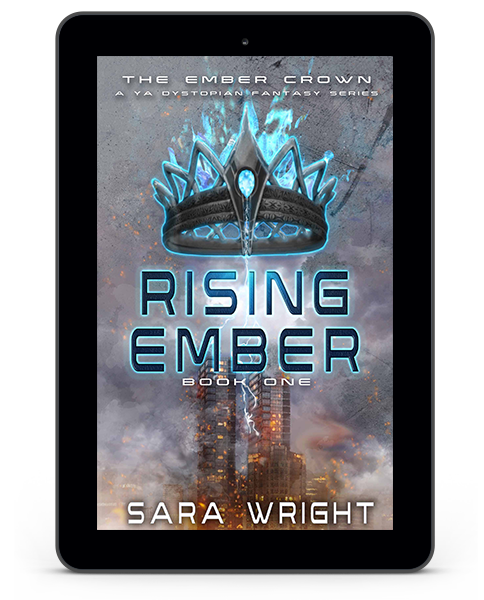A Kingdom Divided Will Burn
- Katharine E Wibell

- Oct 1
- 6 min read

1) Hi there! Let’s begin with you introducing yourself. You can use your pen name if you have one.
Sara Wright
2) How do you pitch your book in one sentence?
A kingdom divided will burn
3) What genre(s) is it?
Young Adult Dystopian Fantasy
4) In your opinion, why do flawed characters make the best heroes?
The Heart of the Story: Why Flawed Characters Make the Best Heroes
I used to believe worldbuilding made a great story—until I realized the emotional journey of flawed characters is what truly hooks readers and makes dystopian fantasy unforgettable.
Every good story starts with an interesting premise—the “what if” statement. Then, it gradually integrates character development, emotional arcs, and familiar genre tropes. It feels like constructing a living, breathing entity.
For me, story premises are sometimes clear, sometimes not. But without an interesting idea, you may struggle to write an interesting story.
If you don’t know what a premise is, here are a few examples of worlds I’ve built so far:
What if a giant spaceship crashed and introduced alien technology to a planet and some people developed the ability to wield the elements while others didn’t?–Forbidden Chronicles
What if there was a perfect society of space-faring elemental wielders, descendants of the architects of the universe, whose sole mission was to protect people from calamity but faced an ancient evil that was unleashed?–The Progenitor Chronicles
But these ideas aren’t enough to make a great story. Ideas are only the starting point, the skeleton of the story, if you will. It’s pure world building which is vastly important for science fiction and fantasy stories, but it’s not the main component to be good. And what you’re really missing is the heart.
The heart of the story is your main characters. They will drive the emotions of your readers. If you really want to connect with them, the main characters’ problems must mirror our world. There is nothing more important than giving your characters’ flaws. This is something I didn’t fully grasp with my debut novel, The Progenitor. What was even more difficult is that I created a perfect world with flawless fairytale like royals who didn’t have problems. So I broke utopia.
Quickly my main character became a shy princess who hated being in the spotlight, which reflects how I’ve lived my whole life. But that wasn’t enough for the story. She had a single flaw, but she didn’t have a problem to fix.
So, I broke it further by taking away the very person who made her feel secure. How would she react when she found out after that person died he had lied to her? Who could she trust now? How would she face the rising darkness that was overtaking her people? And every time I wrote another book in the series, my goal was to break the utopia so that she could rise to fix it.
What was my lesson? Never make a perfect character or world ever again. If I had learned that lesson earlier, I wouldn’t have had a ton of drafts for The Progenitor.
When I sat down to write my next series (Forbidden Chronicles) I did it with intention. My main character would still be a morally good character, but her past would color her with flaws. Her flaws would become emotional arcs that the main side characters would help her overcome.
For example, in the first book of the Forbidden Chronicles, Clarissa wants nothing more than to leave her current life behind. She studies hard to get into medical school, but it’s also her weakness. Her caretaker exploits it to control her, but she doesn’t see how to get out of it.
Consider this situation from Rising Ember: Clarissa is being put in an impossible situation where she could lose everything she’s working for:
“I really hate asking for help, but given the time frame, I don’t have much of a choice. ‘I have to steal something from the town’s selectman’s office.’”–Clarissa, Rising Ember
We learn a lot with this one line. Clarissa doesn’t enjoy asking for help, but she’s desperate, so she’s asking for it anyway. What do desperate people forget to do? Think. And often they become impulsive or rash.
After a little back and forth where her friend learns why she’s been asked to do this, Luna pushes back on her:
“You know you have other options, right?”–Luna, Rising Ember
Her friend is basically pointing out that she doesn’t have to obey her guardian if she doesn’t want to, but it never occurred to Clarissa. She’s been groomed from a young age to fear the consequences of her caretaker, which shapes her identity—a common theme within dystopian literature. And this is a major flaw that she must overcome if she’s going to become the hero her people need.
These interplays between characters that fully flesh them out, building them into real human-like figures that make us want to care about them. It makes us want to fight alongside them. It helps us explore ourselves through their struggles.
However, people are complex. We often have more than one flaw and so should our characters. And to help them overcome those flaws, we have to use the antagonists in our stories to pull on our character’s emotions.
One of the most powerful emotional arcs is love. It’s also an emotion that the villain can easily exploit. Every great antagonist places a hero’s loved ones in danger, maybe even making an impossible choice.
While I don’t believe a romantic arc has to be at the heart of every story to make it good, love is often the driving force of many stories. Just think of Katniss’s driving force. It wasn’t Peeta or Gale—it was Prim, a sisterly bond. The love story was just a bonus, or a path to a life that she had to choose.
However, if the romantic plot is a driving force for the main character, the focus should be on the relationship rather than the physical aspect. Having that deeper relationship actually makes the almost touches and kisses more intense.
I think it’s much more entertaining reading about two characters sitting side-by-side crushing on each other. Their heart rate speeds up, and they become hyperaware of the other person. That their hands are only a few inches away from each other is their sole focus. Their pinks slide across the distance and just when they’re about to touch, the teacher asks them a question. It just makes you want to scream, doesn’t it?
I adore stories that adapt racy romance clichés into a clean, family-friendly format. Rising Ember utilizes forced proximity, a favorite trope of mine. It creates banter and tension between the characters that would not otherwise be there if they could stay apart. It forces them to be together in a way that deepens their relationship as the story goes on and creates conflicting emotions within the main character. When small moments like this happen:
“Gabriel’s presence looms over me as he inches closer, close enough for his breath to tickle my neck, causing goosebumps to rise all over my body.” -Clarissa, Rising Ember
Hopefully, you’ll feel those goosebumps too!
Once you have your heart in place, the rest of the body will form into a story your readers will love. And of course, when they’re hooked, fully focused on the love story, that’s when you throw in the plot twists, cliffhangers, and rip it all away. Which will likely leave your readers screaming for more.
Want to explore more about Clarissa’s journey in Rising Ember? The spark of this alliance starts right here.

5) Can you tell me more about your latest book?
Rising Ember
The Ember Crown Book 1
Dangerous games. Kill or be killed. Can she survive a king's ruthless arena?
Clarissa craves an escape. An orphan forced into criminal acts with other kids by their caretaker, she longs to break free and become a healer. But when an archenemy provokes a deadly confrontation, the seventeen-year-old awakens hidden powers in an explosive and fiery defense.
Seized by soldiers and taken to the capital along with her only friend, Clarissa trains alongside other slaves to fight in the royal army. But surrounded by mysterious strangers and running low on trust, the desperate captive fears graduation day will be her last.
Is Clarissa destined to die in chains?
Rising Ember is the thrilling first book in the Forbidden Chronicles YA dystopian fantasy series. If you like strong-willed heroines, nail-biting drama, and clean slow-burn romance, then you’ll love Sara Wright’s action-packed adventure.
6) Do you have a book trailer to share?
7) Can you tell me a little bit about yourself?
Sara Wright is the author of The Progenitor Chronicles and Forbidden Chronicles, a YA dystopian fantasy series packed with rebellion, elemental powers, and clean slow-burn romance.
She currently lives on Earth, her favorite vacation planet, with her husband and their very opinionated fur baby. But most days, she’s off exploring shattered kingdoms, star-spanning civilizations, and the occasional multiverse with her lifelong companions: Imagination and Creativity.
Raised on bedtime stories and fueled by a steady diet of fantasy, sci-fi, and a sweet topping of romance, Sara now writes tales for readers who crave action, heart, and hope. When she’s not writing, you’ll find her cycling, hiking, or singing dramatically to songs she swears are soundtracks to her books.

8) Do you have a website? If so, what is it?
9) Where else can we find and follow you?
Facebook: https://www.facebook.com/sarawrightbooks
Instagram: https://www.instagram.com/sarawrightbooks
Giveaway
Ends Oct,. 7th 2025
$10 Amazon or Paypal
Follow the tour HERE for special content and a giveaway!































Sara Wright’s world of rebellion and flawed heroes instantly reminded me of how storytelling mirrors craftsmanship much like creating leather jackets in Canada, where every stitch, texture, and imperfection adds to the piece’s authenticity. Just as her characters evolve through their scars, a well-crafted leather jacket gains more personality over time, telling its own story with every wear. Both show how imperfection can create something truly timeless.
Sara Wright’s creativity and storytelling depth in Rising Ember showcase her incredible talent for building emotional connections and complex characters. Her focus on character flaws and growth mirrors the challenges students face in real life learning, improving, and overcoming struggles. Just as Sara crafts powerful narratives, students can strengthen their academic success with business homework help, gaining expert guidance to develop clarity, strategy, and confidence in every assignment.
Thank you for spotlighting my author journey and the book!